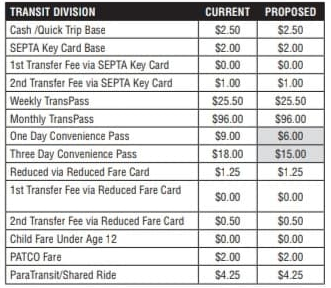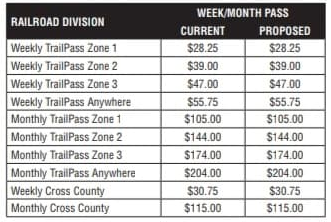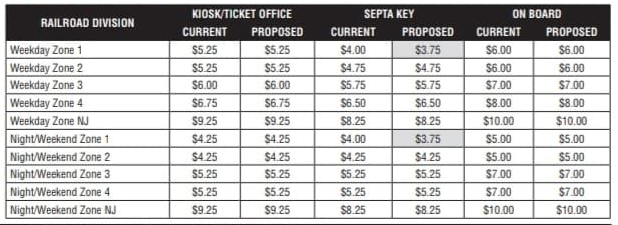Thanks to everyone that participated in the strategic planning through the survey and at our last general meeting. The coordinating committee is actively going through that feedback to make a plan for the TRU moving forward. If you’d like to be involved in that work let us know: org@phillytru.org
Stuff to know
SEPTA’s proposed fare changes
The SEPTA board will be voting on proposed fare changes in May 2022. There’s a lot to like about the proposed changes: there are no increases and even some decreases.
We think SEPTA could go a little further:
- Simplify the fare structure. There are a lot of different, confusing, and conflicting fare options. Just make it easy as possible for anyone to ride.
- Lower regional rail fare within Philadelphia to match transit fare. Now is the time for SEPTA to move toward integrating its transit system.
- Remove ride limits on “unlimited” passes.
- Add a low-income fare program: Allow anyone with a PA Access card to ride for free. We’ve found that statewide this program would cost only $90M/year.
- End the cash payment penalty. There’s no reason to charge cash riders $0.50 more than riders with a card. If the card works for some riders, great. If cash works better, that should be fine too.
- Expand free transfers, don’t charge $0.50 for a 2nd transfer. Riders shouldn’t be penalized for using transit extensively. Allow unlimited free transfers within a 90 minute window.
- Institute fare capping. Today, a weekly transit pass is $25.50. Fare capping would mean that riders who spend $25.50 or more a week would automatically get a weekly pass on their account and not be charged for further rides.
SEPTA’s proposed fare changes




NJTransit’s NewBusBCG
Like SEPTA, NJ Transit is starting work on a bus network redesign in Burlington, Camden and Gloucester Counties. Compared to SEPTA riders, South Jersey bus riders are more likely to be below the poverty line and are less likely to have access to a vehicle. Even before Covid South Jersey transit has suffered from falling ridership and service cuts that have caused ridership to fall even further.
Compared to the SEPTA bus network redesign, the communication from NJTransit is a lot more sparse. However, they did publish a Story Map of existing conditions for bus riders in South Jersey and the slides for the March Zoom meeting were made public. The documents acknowledge the fact that the vast majority of bus service is oriented around hub and spoke service around Camden and Philadelphia. NJ Transit riders who aren’t going to or from these cities generally have to make long, out-of-the-way transfers.
NJTransit will introduce its draft proposals this Fall, and the Final Recommendations and Implementations will happen in the winter of 2022 and 2023. NJTransit is planning on hosting in-person outreach sometime this Summer in South Jersey, at a date and location that has yet to be announced.
In other news, NJ Transit shortened service on the 408, 313, 315, 317 and 409 from Philadelphia to Walter Rand Transportation Center due to safety concerns raised by bay changes at the Greyhound Terminal. Riders taking these busses to Philadelphia have to take PATCO to Broadway Station or take an NJTransit bus (many of them infrequent) on Market St to Walter Rand.
Do you use Transit in South Jersey? What do you think of the bus network redesign and NJTransit’s findings in their Story Map? Have you been effected by the Greyhound Terminal Change? Let us know at org@phillytru.org
Stuff to do
SEPTA Bus Network Redesign
SEPTA’s cost-neutral bus network redesign, “SEPTA Forward: Bus Revolution” is well underway at this point. A cost-neutral bus network redesign attempts to do more with the same resources. This means that there will be no overall increase in transit service; the same number of buses will be running, just running in different areas at different times. Baltimore did a cost-neutral bus network redesign in 2016.
While SEPTA’s redesign is still in the planning phases, we’ve analyzed SEPTA’s route profiles and we expect:
- Overall service in Philadelphia will remain around the same. It’s likely that crosstown routes will see more service in the Northeast, and there’ll be more routes connecting West Philly to the rest of the city.
- Noticeable Increase in Bus Service in the denser parts of Delaware County east of Chester. Hint at increasing service to 15-30 minutes on several routes and creating more crosstown routes.
- Service in the Bucks and Montgomery County suburbs north of Olney will probably stay around the same. Increases and decreases of service along certain routes were suggested to make every bus in the area arrive around every 30-45 minutes.
- Fair likelihood that service around Norristown and King of Prussia will decrease. Most of the route profiles suggest cutting suburban service around Ardmore and Norristown and replacing a lot of lines with microtransit.
- Heavy Decrease of fixed-route service in Lower Bucks County. Hints at replacing a lot of service with microtransit and cutting deviations off of City Routes that serve Bucks County.
SEPTA Planning is scheduling a Zoom meeting this Tuesday (April 19th @ 6:30pm) where SEPTA plans to show two possible bus redesign plans and have the public give feedback on these two different plans.
This meeting is a good opportunity to bring up any questions or concerns you have with the redesign. From experience attending previous meetings, the facilitators tend to take only one question per person and the earlier you ask your question, the more likely they are to answer it.
Some Suggested Questions:
- In what way would either of the proposed changes increase Bus ridership?
- How will SEPTA work with local municipalities to ensure adequate pedestrian infrastructure is built along routes where walking times will be increased?
- 90%+ of riders surveyed expressed a preference for dedicated lanes for busses. Are there plans to add bus lanes on streets that are easily wide enough to support it, like Roosevelt Blvd or Erie Av?
- The Route Profile suggests consolidating North/South service in Philadelphia on a smaller number of streets 5 or 6 blocks apart. Are there plans to convert the streets with consolidated bus service into busways, similar to 14th St in Manhattan, to improve capacity and reliability for riders?
- In areas where fixed route service will be replaced by microtransit, how many vehicles will be allocated to that area, and how long will passengers be expected to wait for a ride?
Coming Up
- TRU non-profit incorporation later this Spring.
- bi-weekly TRU leadership meetings are open to all members. If you would like to attend call/text 267-313-6060 or email org@phillytru.org
- Next General Meeting: May 15, 2022 @ 3pm. Location TBD.
Want to join the TRU? Sign up here